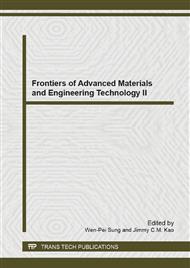p.204
p.210
p.214
p.217
p.227
p.231
p.235
p.243
p.247
Mechanical Properties of High Performance Concrete Subjected to High Temperature as a Function of Fly-Ash and Fiber Addition
Abstract:
The purpose of this study is to have a better understanding of the mechanical characteristics of high performance concrete which is produced by mixing reinforcing fiber controlled by high temperatures with fly ash. After heating up the concrete, its appearance, demolition mode, residual compressive strength, weight reduction ratio and other mechanical characteristics were measured. To improve the mechanical characteristics of concrete, it was mixed with nylon, polypropylene, steel fiber and fly ash. The specimen was exposed to 100 ~ 800°C and its crack control, spalling prevention and other mechanical characteristics were reviewed. When the high performance concrete was exposed to 600°C or higher, its residual compressive strength dropped but its weight reduction ratio was significantly higher than it was heated before.
Info:
Periodical:
Pages:
227-230
Citation:
Online since:
April 2014
Authors:
Price:
Сopyright:
© 2014 Trans Tech Publications Ltd. All Rights Reserved
Share:
Citation:


